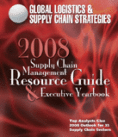
Visit Our Sponsors |
|
|
|
|
|
|
|
|
|
|
|
|
|
|
|
|
|
|
|
|
|
|
|
|
|
|
|
|
|
|
|
|
|
|
|
|
|
|

Analyst Insight
The holy grail of product lifecycle management (PLM) is characterized by a connection of the supply chain, product development, and shop floor under one decision support umbrella that enables more efficient strategic sourcing, supplier relationship management, open innovation, and process planning. As organizational alignment, open innovation, and visibility across the value chain become prerequisites for new product development and launch (NPDL) success, vendors in the product innovation space have a great opportunity to evolve their PLM footprints.
-Jeffrey Hojlo, research analyst at AMR Research
The vision for PLM has always been centralized management of all product knowledge and the enablement of collaboration throughout the product lifecycle: ideation, concept, feasibility, plan, design, launch, production, service, and obsolescence. But so far the adoption of PLM has primarily been driven by product data management (PDM) and collaborative product design (CPD) with internal and external teams, and less by the broad set of decisions required to successfully bring a product to market. To truly be a decision support platform, an application needs to have the ability to calculate product lifecycle cost and support decisions across multiple processes, from ideation, to manufacturing simulation, to aftermarket services. This essentially means managing risk and improving lifecycle value by establishing measures, which break into three distinct categories:
• Strategic benefit-This category gauges the ultimate business value of new products by ensuring goals for revenue, market share, and profitability are met.
• Time to value-Time to value determines not only time to launch, but how quickly a company converts a new product idea into a business benefit.
• Operational excellence-This ensures a foundation of business processes and best practices is in place to support repeatable NPDL success.
The NPDL process includes more than the foundational elements of PDM and collaborative product design. It encompasses a broad array of people and processes across multiple domains, including product development, product management, manufacturing, marketing, and the supply chain. This reinforces the need for a PLM decision support layer to ensure the right products are designed and manufactured by the right people-efficiently, cost effectively, and on time.
The Final Frontier for PLM
The primary areas of opportunity that define the future of PLM for users and vendors all fall under the umbrella of decision support:
• Connecting disparate applications and data sources-As we have previously stated, each group sees product information through the lens of its own role-CAD geometry, manufacturing processes, spare parts data, pricing, and packaging-so it's critical to enable role-based views inside and outside the company for faster decision support. A service-oriented architecture would reduce these complexities.
• Single user interface-Most companies don't have a single product knowledge interface that contains the relevant information for engineering, manufacturing, service, marketing, sales, partners, and customers. Creating a single UI with personalized product portals for each constituency would alleviate this challenge.
• Customer needs management-This segment has been in the AMR Research PLM footprint since the its inception, but its growth didn't take off until the last two years. As companies reach new levels of PLM maturity with PDM and process management, they begin to think about linking customer data with the front end of design.
The Outlook
The opportunity for PLM is expanding. Our outlook for the PLM market remains optimistic, with a projected 11 percent CAGR through 2011. Manufacturers are driving this projection by placing a top priority on managing and introducing products, compared to the low investment to date in PLM versus ERP and other application categories.
RELATED CONTENT
RELATED VIDEOS
Timely, incisive articles delivered directly to your inbox.

